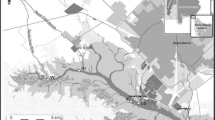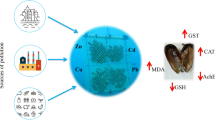Abstract
Preliminary results on the application of the inducible metal binding protein, i.e. metallothionein (MT) as a biomarker for the assessment of metal exposure of indigenous mussels Mytilus galloprovincialis Link are presented. This study is an amendment of the long-term monitoring program of the coastal seawater area [1] by which the metal body-burden in edible bivalves has been monitored. An attempt is made to get the additional and relevant information on the biological response of the widespread, sessile and filter-feeding marine organisms, often used to monitor metal pollution of the marine and the estuarine coastal areas [2].
Access this chapter
Tax calculation will be finalised at checkout
Purchases are for personal use only
Preview
Unable to display preview. Download preview PDF.
Similar content being viewed by others
References
Monitoring programme of the Eastern Adriatic Coastal Area, Report for 1983–1991 (1994) MAP Technical Report Series No. 86. UNEP, Athens.
O’ Connor T.P, Beliaeff B (1995) Recent trends in coastal environmental quality: Results from the mussel watch project. NOAA, Silver Spring MD.
Roesijadi G (1992) Metallothioneins in metal regulation and toxicity in aquatic animals. Aquat Toxicol 22: 81–114.
Pavčić J, Škreblin M, Raspor B, Branica M, Tušek-Žnidarič M, Kregar I, Stegnar P (1987) Metal pollution assessment of the marine environment by determination of metal-binding proteins in Mytilus sp. Mar Chem 22: 235–248.
Brdička R (1933) Polarographic studies with dropping mercury cathode. Part XXXI- A new test for proteins in the presence of cobalt salts in ammoniacal solutions of ammonium chloride. Collect Czech Chem Commun 5: 112–128.
Olafson RW, Sim RG (1979) An electrochemical approach to quantitation and characterization of metallothioneins. Anal Biochem 100: 343–351.
Pavičić J, Raspor B, Martinčić D (1993) Quantitative determination of metallothionein-like proteins in mussels; Methodological approach and field evaluation. Mar Biol 115: 435–444.
Martinčić D, Kwokal Z, Branica M, Stoeppler M (1987) Trace metals in selected organisms from the Adriatic Sea. Mar Chem 22: 207–220.
Author information
Authors and Affiliations
Editor information
Editors and Affiliations
Rights and permissions
Copyright information
© 1999 Springer Basel AG
About this chapter
Cite this chapter
Raspor, B. et al. (1999). Assessment of metal exposure of marine edible mussels by means of a biomarker. In: Klaassen, C.D. (eds) Metallothionein IV. Advances in Life Sciences. Birkhäuser, Basel. https://doi.org/10.1007/978-3-0348-8847-9_94
Download citation
DOI: https://doi.org/10.1007/978-3-0348-8847-9_94
Publisher Name: Birkhäuser, Basel
Print ISBN: 978-3-0348-9799-0
Online ISBN: 978-3-0348-8847-9
eBook Packages: Springer Book Archive




